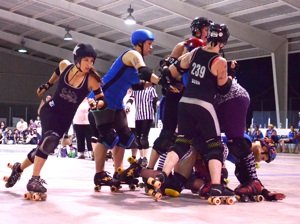Roller Derby Rules

Roller Derby is a popular team sport that is played in the United States of America and a range of other countries across the world. It is a full contact sport that is action packed and exciting for both competitors and spectators. The sport has a number of governing bodies, but by far the largest is the Women’s Flat Track Derby Association, that looks after over 400 leagues, reflecting the fact that it is a game that is predominantly played by teams of women.
However, there are more and more men taking up the game, and another governing body, the The Mens Roller Derby Association has been formed to look after this side of the game. Many different countries also have their own national governing bodies.
Object of the Game
The object of Roller Derby is simple. Each team is trying to score more points than the opposition. Points are awarded when the offensive player from one team, known as the jammer, laps a member of the opposing team. As a full contact sport, the defensive players of the opposing team, known as blockers, can use physical force to stop the jammer passing them, as well as helping to clear the way for their own jammer.
Players & Equipment
Each rollerball team consists of up to 14 members but fields five players at a time, four of which are known as blockers, and one being a jammer. The single jammer on each team is the only member who is allowed to score, and they are signified by the star that they wear on their helmet. Of the four blockers, one of these is known as the Pivot. The Pivot acts like a captain or pack leader, and makes the defensive play calls.
All players skate on quad roller skates rather than inline skates. This is because quad skates have a smaller wheelbase which means there is less chance of skaters tripping on each other’s skates. They are also generally more stable and easier to control, which makes things easier for players considering the combative nature of the sport.
Other equipment that players are required to wear include mouth guards, knee and elbow pads, wrist guards and a helmet. Gender specific protective gear may also be worn, such as protective sports bras for women and a groin guard for men.
Scoring
Scoring in Roller Derby can only occur during periods of time known as jams. These occur throughout each half and last for up to two minutes, though the lead jammer can call them off earlier. Points are scored during the jam when a team’s jammer laps members of the opposing team. To try and prevent this, the opposing team will use a whole host of tactics such as blocking and body contact to try and prevent this happening. The jammer scores a point for each member of the opposite team that they lap.
Winning the Game
The team that has the most points at the end of the match is deemed the winner. Because Roller Derby matches are not allowed to end in a tie, an overtime jam occurs to determine the winner. The overtime jam has no lead jammer and the team with the most points at the end of the jam is declared the winner. If the match is still tied, then successive jams will occur until a winner has been found.
Rules of Roller Derby
- Roller derby teams may consist of up to 14 players, but only 5 may be on the track at any one time. These shall consist of:
- 1 jammer: The jammer is the only member of the team who can score points
- 4 blockers: These are defensive positions whose aim is to block the opposition jammer lapping them and therefore scoring. One of the blockers is known as a pivot, and it is they who are in effect the team captain, calling the shots.
- Roller Derby matches are played in two periods lasting 30 minutes each.
- Roller Derby is played on a track that is oval. At the start of a Roller Derby match, the blockers from each opposing team skate as one single pack around the track. Once the pack passes the starting line and the last member of the track is 30 feet from it, a whistle is blown and the two jammers (one from each team) begin to skate.
- Each jammer must then skate as fast as they can and then fight their way through the pack. Once this has been done, the jammers are then in a position to score.
- Each jammer can then score by racing round the Roller Derby track and overtaking (lapping) members of the opposite team. For each member of the opposition team that the jammer passes, they score one point.
- Blockers can use physical force to prevent the opposition jammer passing them and scoring.
- Each jam lasts for up to two minutes.
- Penalties can be issued for a variety of reasons. These can include:
- tripping
- blocking above the shoulder
- blocking a player when out of bounds
- blocking with the arm below the elbow
- charging from the rear
- At the end of the match, the team with the highest number of points is declared the winner.
- If the match is tied, an overtime jam occurs, and jams keep occurring until one team has a greater number of points at the end of the jam and is declared the winner.